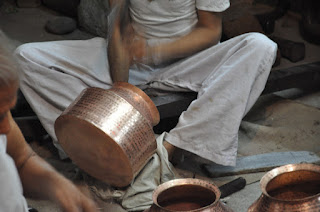Two thoughts a came to mind, both similar in process: - participants could personalise a standard design on flat sheet of card using coloured pencils, cut it out,learn to fold and form it to make a 3D object, add their own creation as part of a larger shared collaborative piece. They can also make another to take home.
Looking back through the sketchbooks my first thought was to make a wall panel of folded flowers - paper versions of the metal ones in the show and inspired by the textiles, garlands and offering flowers I had seen in India and Bangladesh, the block printing, the wall paintings and the project with the children at the school. Individuals could colour in their own flowers or add messages to the petals, then pin them together with others to make a vivid panel of colour and texture.































































